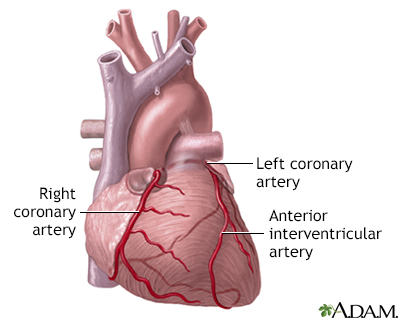Pregnancy SmartSiteTM
Sestamibi stress test; MIBI stress test; Myocardial perfusion scintigraphy; Dobutamine stress test; Persantine stress test; Thallium stress test; Stress test - nuclear; Adenosine stress test; Regadenoson stress test; CAD - nuclear stress; Coronary artery disease - nuclear stress; Angina - nuclear stress; Chest pain - nuclear stress DefinitionNuclear stress test is an imaging method that uses radioactive material to show how well blood flows into the heart muscle, both at rest and during activity. How the Test is PerformedThis test is done at a medical center or health care provider's office. It is done in stages: You will have an intravenous (IV) line started.
Most people will then walk on a treadmill (or pedal on an exercise machine).
Your blood pressure and heart rhythm (ECG) will be monitored throughout the test. When your heart is working as hard as it can, a radioactive substance is again injected into one of your veins.
Your provider will compare the first and second set of pictures using a computer. This can help detect if you have heart disease or if your heart disease is becoming worse.  How to Prepare for the TestYou should wear comfortable clothes and shoes with non-skid soles. You may be asked not to eat or drink after midnight. You will be allowed to have a few sips of water if you need to take medicines. You will need to avoid caffeine for 24 hours before the test. This includes:
Many medicines can interfere with blood test results.
How the Test will FeelDuring the test, some people feel:
If you are given the vasodilator drug, you may feel a sting as the medicine is injected. This is followed by a feeling of warmth. Some people also have a headache, nausea, and a feeling that their heart is racing. If you are given medicine to make your heart beat stronger and faster (dobutamine), you may have a headache, nausea, or your heart may pound faster and more strongly. Rarely, during the test people experience:
If any of these symptoms occur during your test, tell the person performing the test right away. Why the Test is PerformedThe test is done to see if your heart muscle is getting enough blood flow and oxygen when it is working hard (under stress). Your provider may order this test to find out:
The results of a nuclear stress test can help:
Normal ResultsA normal test most often means that you were able to exercise as long as or longer than most people of your age and sex. You also did not have symptoms or changes in blood pressure, your ECG or the images of your heart that caused concern. A normal result means blood flow through the coronary arteries is probably normal. The meaning of your test results depends on the reason for the test, your age, and your history of heart and other medical problems. What Abnormal Results MeanAbnormal results may be due to:
After the test you may need:
RisksComplications are rare, but may include:
Your provider will explain the risks before the test. ConsiderationsIn some cases, other organs and structures can cause false-positive results. However, special steps can be taken to avoid this problem. You may need additional tests, such as cardiac catheterization, depending on your test results. ReferencesAmsterdam EA, Wenger NK, Brindis RG, et al. 2014 AHA/ACC guideline for the management of patients with non-ST-elevation acute coronary syndromes: a report of the American College of Cardiology/American Heart Association Task Force on Practice Guidelines. J Am Coll Cardiol. 2014;64(24):e139-e228. PMID: 25260718 pubmed.ncbi.nlm.nih.gov/25260718/. Dorbala S, DiCarli MF. Nuclear cardiology. In: Libby P, Bonow RO, Mann DL, Tomaselli GF, Bhatt DL, Solomon SD, eds. Braunwald's Heart Disease: A Textbook of Cardiovascular Medicine. 12th ed. Philadelphia, PA: Elsevier; 2022:chap 18. Fihn SD, Blankenship JC, Alexander KP, et al. 2014 ACC/AHA/AATS/PCNA/SCAI/STS focused update of the guideline for the diagnosis and management of patients with stable ischemic heart disease: a report of the American College of Cardiology/American Heart Association Task Force on Practice Guidelines, and the American Association for Thoracic Surgery, Preventive Cardiovascular Nurses Association, Society for Cardiovascular Angiography and Interventions, and Society of Thoracic Surgeons. J Am Coll Cardiol. 2014;64(18):1929-1949. PMID: 25077860 pubmed.ncbi.nlm.nih.gov/25077860/. Flink L, Phillips L. Nuclear cardiology. In: Levine GN, ed. Cardiology Secrets. 6th ed. Philadelphia, PA: Elsevier; 2023:chap 8. | |
| |
Review Date: 10/5/2022 Reviewed By: Thomas S. Metkus, MD, Assistant Professor of Medicine and Surgery, Johns Hopkins University School of Medicine, Baltimore, MD. Also reviewed by David C. Dugdale, MD, Medical Director, Brenda Conaway, Editorial Director, and the A.D.A.M. Editorial team. The information provided herein should not be used during any medical emergency or for the diagnosis or treatment of any medical condition. A licensed medical professional should be consulted for diagnosis and treatment of any and all medical conditions. Links to other sites are provided for information only -- they do not constitute endorsements of those other sites. No warranty of any kind, either expressed or implied, is made as to the accuracy, reliability, timeliness, or correctness of any translations made by a third-party service of the information provided herein into any other language. © 1997- A.D.A.M., a business unit of Ebix, Inc. Any duplication or distribution of the information contained herein is strictly prohibited. | |

 Nuclear scan
Nuclear scan Anterior heart art...
Anterior heart art...
